Gizmo’s antenna mast 2013: FLIR, Rogue, Wilson & more
I’ve heard it said that if you heeded all the manufacturer advice about antenna placement, you’d need a boat 100-feet long with four or five masts. I’ve been meaning to ask Panbo readers about how to best use Gizmo’s single (though beefy) antenna mast, but instead I went and rejiggered everything last week and your advice will have to wait for the next revision. What mainly drove the change is the long term loan of a FLIR M-Series camera system, which certainly deserves the premier masthead position…
I’ve already tested a “dual payload” M-Series (thermal and lowlight cams) and the neat install details have not changed, but this FLIR M-618CS model includes gyro stabilization and the thermal imagery has probably been improved (image processing has a lot to do with the finished results). The really big change, though, is how the FLIR can be tightly integrated with many MFDs now, including recent models from Raymarine, Furuno, and Navico. Not only will I be able to pan and zoom the M618, plus manage color palettes and other nuances, with the included controller but I should be able to enable the same control from several of Gizmo’s touch displays, plus the ability to lock onto AIS targets, waypoints, radar blips and other critical navigation objects. How much this generally increases the operational value of the (expensive) camera system, and how well the specific MFD integrations work, will be an interesting project.
Meanwhile Land and Sea WiFi loaned Gizmo a WaveWiFi RoguePro kit (above) which meant I could do a neat install at mast spreader level. I suspect I’ll get a bit more range and durability than the regular Rogue Wave I’ve long tested (though it’s still going strong on the fly bridge rail). I was impressed how complete the Land and Sea kit has become. What you see above is everything you probably need to install the RoguePro plus your boat’s onboard WiFi router all powered either by 12v DC or 110v AC. Land and Sea will even program your desired onboard hotspot name into the Netgear router, and there’s a bit of Rescue Tape to “belt and suspenders” the antenna to RoguePro connection.
One of the beauties of the Rogue (and other high power marine WiFi systems like and the WirieAP or the Nauticloud) is that your install is not limited by the constraints of USB or coax cables. Unfortunately the same techniques do not apply to high-power cell boosters and that’s why I’m about to try snaking that Wilson400 Ultra-Low-Loss coax cable from the mast spreader to the pilothouse (wish me luck, please). I could have used lighter cable but I attended an electronics trouble shooting seminar at IBEX where one thing all the pros seemed to agree on was how valuable LMR400 coax is for maximizing performance, particularly on high frequencies, and minimizing EMI issues…
Besides, since Wilson has decided to loan Gizmo the mother of all cell boosters, I figured I ought to go for maximum performance. The SignalBoost dual band at left above is the one I installed with a Digital antenna just before I left Maine last fall, and it really helped in places where the Verizon signal was weak. (You can see how it and other antennas were set up here.) Then in January, when Wilson decided to pay more attention to the marine market, I bench tested that AG SOHO 60 and some other gear like the Wilson marine antenna now mounted at the spreaders. I’ll be able to test any of these but the one that should zip up data or voice connections for any phone on Gizmo is the new AG Pro Quint.
What about VHF and AIS? Well, I moved the 8-foot Shakespeare installed on the spreaders last summer a little lower but suspect it will still be the boat’s longest range VHF/AIS stick (size matters I learned, and I use the 8 with an excellent Vesper antenna splitter). The two VHF/AIS backup whips, one GAM and one Shakespeare, were moved from masthead to the spreaders (yes, they’re close to the cell and WiFi antennas but won’t often be used simultaneously and I wanted to keep all of them as far out of the stainless steel shrouds as possible). I was thinking somewhat of symmetry but also of keeping the antennas within the protective cone created by that Lightning Electrotechnologies “Streamer Inhibitor” — also known as Gizmo’s peace halo. I don’t know if I’ll ever see it tested, but ever since I wrote about the sample (later replaced a larger halo specifically designed for Gizmo) I’ve felt dumb when it wasn’t installed.
I do want to get one of the “peace” spokes lined up with the bow, and eventually a similarly three legged aluminum top plate might do a sharper job of mounting the FLIR plue Maretron and Airmar ultrasonic weather stations (than the Azek boards I’m using now). But will I find other things I want to change? What do you all think?


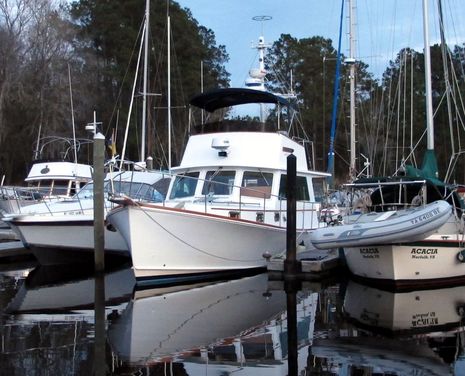
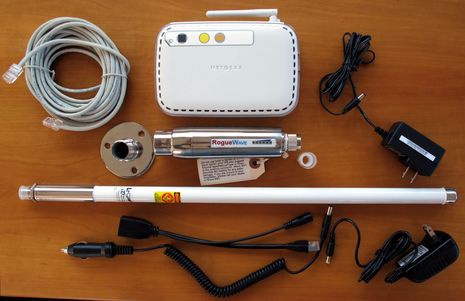
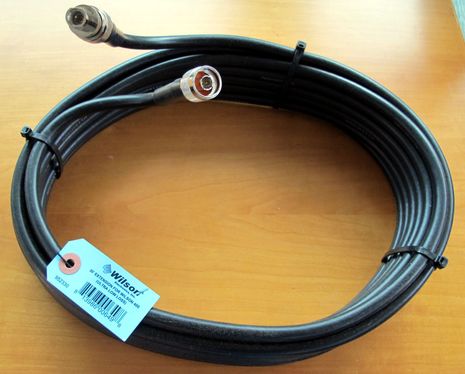
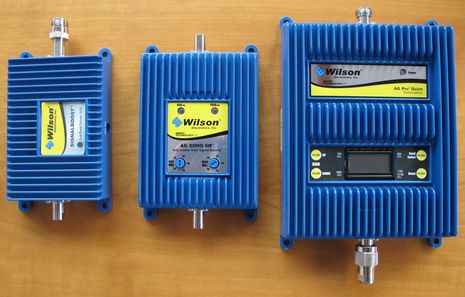
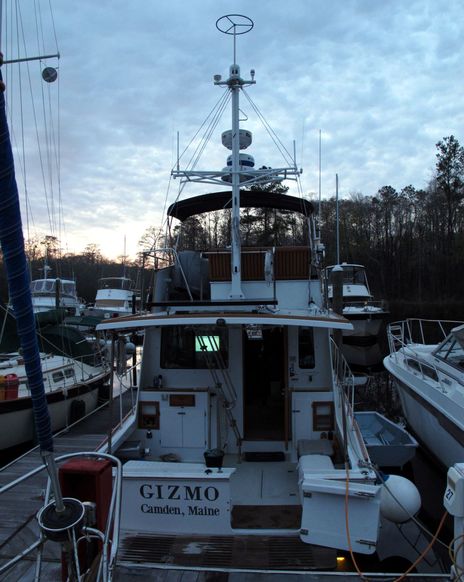
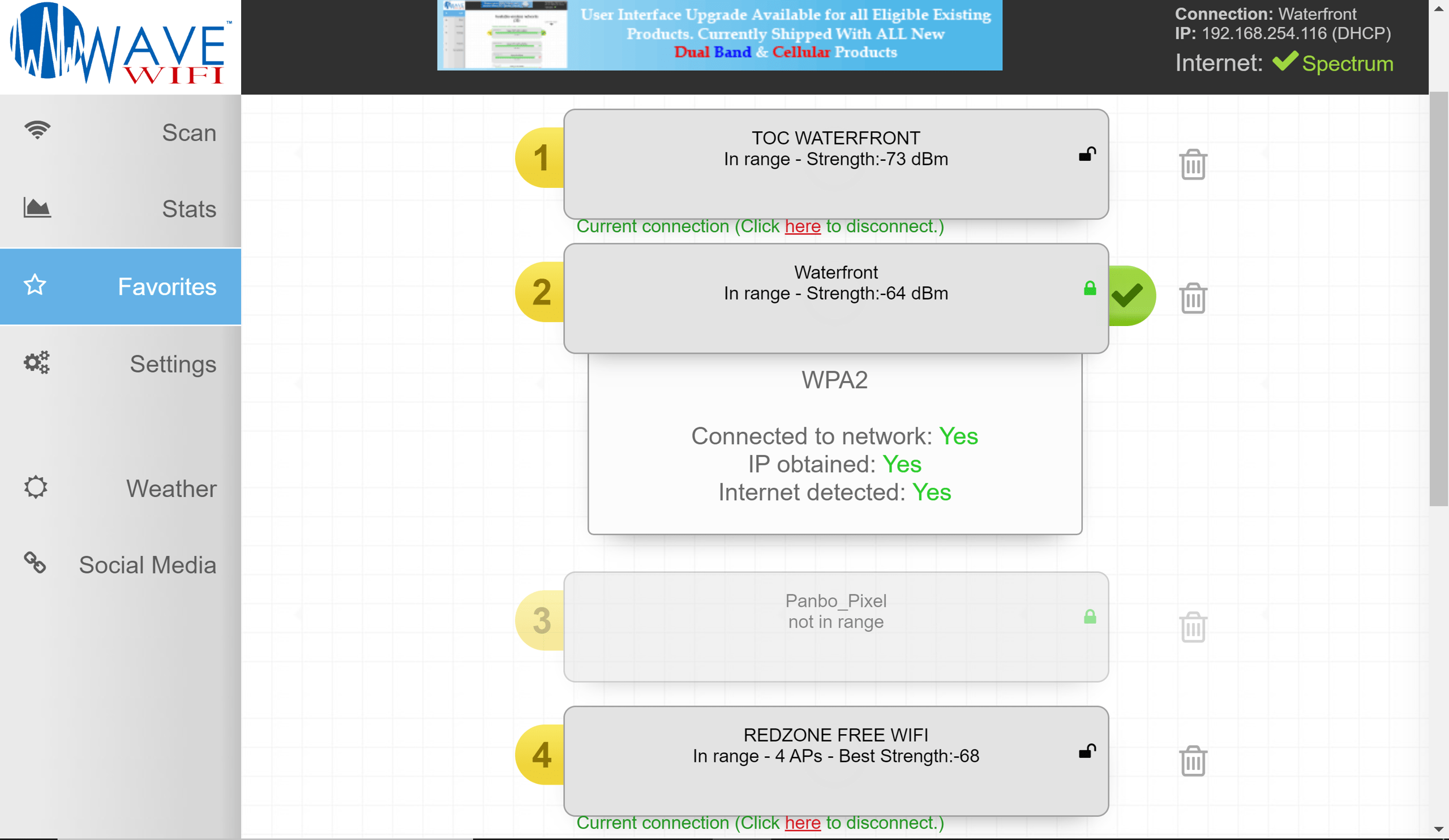

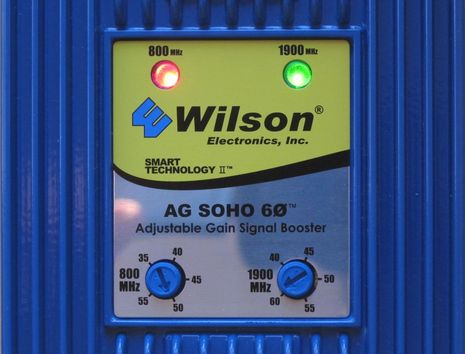








You’re making a mistake on the cellular amp. Those amps won’t provide any help with 4G/LTE signals. In fact, it’ll degrade your signal strength on those bands.
4G/LTE is available through about 30% of the ICW now. Perhaps even more this spring. You’re giving bad advice about showing which cellular amp to use.
Anon, it would be more useful if you gave some references to back up your criticism.
As for 4G/LTE, I saw quite a bit of Verizon’s along the part of the ICW I transited last fall, and I never detected the basic Wilson booster negatively effecting it. And while I was away, Verizon enabled 4G where I live in Maine and so that’s what I tested the SoHo 60 with. Again I saw no degradation.
Wilson does not claim that either of those boosters helps with 4G but the big AG Pro-Quint purportedly “boosts signals on 800 MHz, 1900MHz, AWS and both AT&T and Verizon 700 MHz 4Gnetworks.” In fact, its main claim to fame is helping people get the most out of growing 4G coverage. Did you miss that?
At any rate, I will try to see if AG Quint really can improve Verizon 4G. But, by the way, if you poke around Panbo more, I think you’ll see that we don’t really advise people what to buy. We just try stuff and report on the results as best we can.
Ben,
Speaking of cell boosters, have you seen this regarding booster registration?
http://blog.chron.com/techblog/2013/02/fcc-orders-cell-boosters-to-be-registered-or-turned-off/
Also, according to the FCC FAQ on this ruling ( http://wireless.fcc.gov/signal-boosters/faq.html ) boosters meeting the new regs are not yet available.
It would be interesting if someone from Wilson Electronics could weigh in on this. I’d be interested in hearing an opinion from within the industry.
-Tim
Thanks, Tim! No, I didn’t know about this, and couldn’t find in there when it takes effect, or what the new regs mean for existing boosters, but I’ll bet Wilson knows a lot about all this. I will ask.
I do know that interference with cell towers was an early problem with boosters and that Wilson claims of the AG Quint Pro “Like all Wilson signal boosters this unit features cell site protection technologies refined over more than a decade of research and development.”
Tim, I think I’ll hear back from Wilson tommorrow but in the meantime here’s some info that seems quite positive about what the FCC did:
http://www.cepro.com/article/fcc_tweaks_cell_signal_ruling_manufacturers_react/
The piece includes: “Meanwhile, despite being opposed to the registration requirement for consumers, Wilson Electronics’ COO Joe Banos called the ruling ‘a major victory not only for our industry, but also for the end users who benefit from added levels of safety, security and satisfaction with their service through the use of signal boosters.'”
Ben,
I’m VERY interested to hear your findings on the Wilson boosters. I have 2 on the boat now. I can’t remember the model names, but 1 is a wireless and the other is a direct connect. Wilson says the wireless model is the more advanced, but the direct connect seems to do a better job most times. I have it connected to a 3G Internet hub so I can work on the boat from anchorages. It works but it’s not flawless and performance ranges from great to terrible – sometimes even in the same spot.
I think I’m at the edge of where I’m getting signals, so maybe a stronger booster would help. That new unit is pricey so I’m hesitant.
I am not sure that the amps in the picture will handle 4G signals. Last Dec I emailed Wilson about a booster for our 4G Verizon Mifi. They recommended a Wilson 815125 Sleek 4G-V and a Wilson 308430 50 Ohm High-Gain Marine Antenna.
With the Sleek, we noticed a big improvement in speed with our Verizon MIFI, even in areas with good cell coverage. Now our boat wifi speed when on 4G is nearly as fast as our DSL connection at home, and faster than most marinas wifi. The sleek will boost a 3G or 4G signal, but it won’t create a connection if there is nothing there. Several times we have noticed that we went from 4 bars to no bars in only a few miles.
The most important thing to keep in mind when installing any cell booster is to mount the antenna as far away from the booster as possible. The Sleek, and probably other Wilson boosters, have a circuit which reduces power if it detects feedback. The Wilson marine antenna comes with a 20 ft cable. Use it all.
Thanks, Rick, but that big AG Quint Pro pictured up there is definitely designed to boost either Verizon or AT&T 4G. It didn’t exist when you talked to Wilson and I’m not sure it’s shipping yet.
Also regarding antenna separation, I think the trick is not so much distance as direction. The marine antenna is “omni-directional” but most strongly on the horizontal plane. So its best to put an interior directional antenna directly below and facing away from the main antenna. I have two interior antennas to try out, plus a cradle, and I believe that the AG Quint will give me detailed info about feedback issues on that little LCD screen as I do the installs.
Tim, Wilson has posted a very positive press release about the FCC ruling here: http://goo.gl/jH39Z
The release also states that the new regs don’t take effect until March 1, 2014.
And, finally, Wilson pointed me to this update to the orginal Ars Technica blog entry:
http://goo.gl/2NckY
Sounds like we’re good
I have an interesting problem for this years boating internet needs. Most of my work is done by VPN connections to client networks and phone calls, so I do most of it during the summer from anchorages. As I stated in my last post, my reception has been okay, but could be better.
I’m in Ontario, Canada and my cell phones are with Rogers Wireless. I don’t have a contract for my wireless Internet hub, because I didn’t want to pay all winter, but because of that I can switch providers at will now. I looked at both Rogers and Bell (the 2 big providers here) coverage maps and they both claim to cover most of the areas I go to regularly. The difference is that Bell seems to have the far superior coverage and they claim LTE (up to 75mb) in almost all my boating areas in southern Georgian Bay.
So I’m left with 2 choices: Rogers 3G with the booster, or Bell LTE without. Your review of the Quint could add a clear third choice: Bell LTE with boost.
I called a supplier in Ontario and they tell me the Quint is for large buildings only and the separation between the internal and external antenna needs to be over 60′ and that the external antenna is going to be the weakest link in my marine system. He suggested that I hold off and just buy a better external antenna, which he is going to recommend but has not yet.
I have the Wilson marine antenna now. What antenna are you using, Ben? Do you have any experience with other or have any recommendations?
I’ve thought the antenna was the weak point on my system and to help, I added a 6′ extension to raise it higher late last year. It helped a little, not much.
Again, thanks for posting this topic! I rarely see any trustworthy, informative information on this to know whether they work or are snake oil.
When I received my Rogue Wave Pro, I was disappointed by the notice tagged on the antenna connector “Wave WIFI assumes NO liability for any water damage” (as shown in the picture above). I bought this model for it’s claimed “enhanced dust and moisture resistance” (as well as ability to mount to a 1-14 standard antenna fitting) but, apparently, there is none. As the antenna connector has not changed and since this is where water will enter, I don’t see how it should offer enhanced moisture resistance. So I will use polyurethane sealant liberally on the antenna connector but, by mounting it outside, I will void my warranty.
A better solution would have been a mount like the one my VHF antennas have (http://www.acmarine.dk/sites/default/files/productsheets/CX4.pdf). The antenna is held in place by a 1.25” thread nut going over the bottom part of the antenna and, via an o-ring, forming a complete seal against the antenna body. This will be watertight, and has been at the top of my mast for 6 years, unless water flows upward or I suffer a knockdown.
And somewhat off-topic on the router: I have used a Netgear MBRN3000 3G router for the last season. It worked well but does not allow to either/or use the UMTS modem or a wireless bridge like the Wave Wifi/Ubiquity Bullett. I also didn’t like that it constantly felt warm to the touch and so must be using a lot of idle power.
Not wanting to spend on something like a Pepwave router, I have now found a TP-Link TL-MR3220 that provides the two-way switching ability (the feature is called a “backup” directed at the “DSL as main connection – 3G as backup” scenario but this can be selected manually as well). While a Pepwave router can handle 4 different connections, mine only has two but that’s all I need. And when I measured the power usage I found 90 to 130 miliamps for the TP-Link vs. 390 to 450 miliamps for the Netgear where the TP-Link values include the loss of a DC-DC converter form 12V to 9V. All this for EUR 25 vs. 100 for the Netgear.
How is the AG Pro Quint performing? Its a big investment…..
Don
Yes and no, Don. The Pro Quint is remarkable technology, almost invariably able to improve reception on all three frequencies my Verizon 4G phone uses in marginal areas, and very easy to adjust to changing situations.
But it’s really too powerful for a boat like mine where the separation between outside and inside antennas is about 15 feet. I’ve tried three different inside antennas and several positions but almost always have to keep the individual amps way below their maximum power.
I had a good phone session with a Wilson tech guy last week and plan to try some aluminum radiation shield be improve the antenna separation and also to test in further downeast Maine where reception is really poor. Best news, though, is that Wilson is working on an intermediate model that still boosts all four bands like the Quint does but doesn’t have the little screen and costs less.
Thanks Ben,
how much separation would be sufficient? Have the Wilson engineers made suggestions? I can’t judge from the product literature. I could put it above the 100′ deck stepped mast and have the interior antenna directly below……
Don
Ben my suggestion is to use only direct connect cellular bi-directional amplifiers with low gain. I use the Wilson Quad-band marine Omni’s for my Pantec UML290 LTE/ EVDO Verizon USB modem. The modem allows me to connect a 700MHz dedicated direct connect amplifier to the LTE 700MHz port and an older Digital direct connect 3G 800/1900MHz amplifier on the 3G port. The Pantec has an 18″ USB extender to get it away from my CradlePoint CTR35. The WiFi radio is turned off on the CradlePoint it feeds a 4 port Wave WiFi failover selector WAN switch. The switch feeds a Ubiquiti 802.11a & N 5GHz access point. My Ericsson W35 is attached to it’s own Wilson quad-band antenna with the internal WiFi turned off. It also feeds a WAN port on the Wave switch. My Sprint 3G USB modem is attached like the Pantec modem to it’s own CradlePoint CTR35 w/ WiFi disabled it feeds the 3rd port on the Wave switch. The final 4th port on the Wave switch is fed by my EC high power WiFi bridge unit. I have the internal rebroadcast 802.11b & g 200mw access point removed. I also have a stand alone Ubiquiti 5GHz Rocket (MIMO) with a 5GHz dual polarity 15dbi Omni mounted on my hardtop. It feeds a stand alone switch which gives me high QOS when I am at my home marina by connecting to a dedicated 5GHz outdoor N MIMO access point. I can either feed this into another 5GHz AP inside the boat or a 2.4GHz low power AP which is usually turned off. My Linksys SPA1001 SIP/VOIP converter is fed off of this stand alone 5GHz network switch. The switch also feeds a laptop and an IPTV box. I can patch this switch into the Wave switch if needed.
If needed I can simply turn on any 2.4GHz access point in the Ericsson W35 or either CradlePoint router as needed.
This all works very well for me at about a 1/2 mile the 5GHz system gives me up to 30mbps DL and 10 mbps UL.
I think the sooner cruisers adopt to using the 5GHz 802.11a & N band as access points in their vessels they will see improved network speeds and much better 802.11b, g & N ship to shore WiFi speed, QOS and distance.
That’s what works for me in Wireless One.
Bill Lentz
1993 Mainship 40SB
Ben,
Did you switch antennas when using the Wilson Quint Pro? I noted the specs for the Wilson “marine” antenna in the 2110-2170 MHz range isn’t that great.
How much seperation is needed? With any booster or Bi-directional amplifier that uses a donor antenna (outside the vessel) and a rebroadcast antenna (inside the vessel) you need the total gain needed to amplify the distant cellular signal plus 15db of additional head room (isolation) so there is no RF feedback.
A quick example would be a 60db gain amplifier needs 75db of total isolation. That’s pretty hard to do with small to medium sized fiberglass boats.
This is why I always recommend only direct connect bi-directional amplifiers. They are similar to running the BDA as a closed loop system. It’s not too difficult to get the required isolation when these conditions are met with a direct connect BDA. The gain needed to produce a usable signal is less with a direct connect BDA and the isolation is easy to acheive when you start out needing lower gain and the inside device has a shielded cable directly feeding it.
I have never seen a direct connect BDA get into an RF feedback condition.
It’s also a well known fact that when AGC (auto gain control) is used with a 3G CDMA EVDO signal that data speeds are severly impacted. How much are they impacted by AGC? RAN Lab numbers indicate anywhere from 30 to 100% reduction in data speed compared to a BDA that uses ALC and AGC is disabled. This isn’t something that can generally be done with the lower end bi-directional repeaters (BDAs).
It might be worth repeating choose a cellular data modem that has seperate 3G and 4G LTE ports. This will allow you to install the older (in the US) 800/1900MHz dual band BDA on one port and a 700MHz LTE direct connect BDA on the 4G port. This really applies to Verizon Mobile here in the US. The PanTec UML290 is one USB cellular modem that has seperate 3G/ 4G ports. It’s what I have been using with and without direct connect repeaters. I find that most of the time I don’t need the BDAs. I started using the Wilson quad band Omni antennas last year. These appear to have about 13db of return loss at 700MHz they sweep better at PCS 1900MHz frequencies.
Bill Lentz
Wireless One
1993 Mainship 40SB
Henning, the Wave ROGUE/ or Pro point of moisture failure is not the antenna N connector. An N connector is water proof by it’s own specification. No water will ever enter the unit through the back of the N connector. If moisture was to get into the N connector it wouldn’t damage the unit, it would however kill the performance until the moisture is removed.
The real point of entry that Ubiquiti and Wave have little control over is the CAT5 ethernet connection. Water in this connector can enter the unit and will damage the unit. Water can travel uphill, it’s called “wicking”. This is why it’s real important to install the proper O ring and cable gland when the unit is mounted outside. I recommend using some weather proofing self vulcanizing tape. This goes for the Wave Pro or the standard ROGUE. If the unit is mounted on a threaded mast the chance of moisture getting into the CAT5 connection is almost nill.
Something to ponder when planning a Wave ROGUE, Pro or a Ubiquiti Bullet 2HP.
Bill Lentz
Sigh,
I guess you never disassembled a failed RogueWave. What fails is the o-ring between the N-type connector and the body of the bullet. So the leak is from the top. On the two that I have taken apart, both had this leak. There was no evidence of water coming in via the RJ connector access.
Don
Bill,
Interesting observations. It would seem that putting up a higher gain antenna with a flatter distribution would do the trick to minimize feedback. Might not work so well on vessels that heel or rock, but perfectly fine for a catamaran such as ours. I guess I’ll have to go calculate the field strength vs. distance directly below a 9 dB stick antenna.
Don
I have taken Bullets apart but I have never had that failure with a ROGUE or a Bullet 2HP or the 5GHz version.
I would assume this was caused by improper installation of too large an antenna coupled directly to the unit’s N female where a bracket hold the assembly at the base or from a similar setup whacking a bridge or overhead obstruction?
I have some of the original Wave ROGUE (clients) and Bullets (used as APs) in service for years.
Don are you saying this is a design flaw or installation related?
Thanks,
Bill
The o-ring seating on the bullet is a commonly used seating technique. Whether something is a design flaw is a function of the design goals which often are in conflict. Absent any knowledge of these goals, I would hesitate to call this a design flaw. Having said that, there are better ways to make a stationary o-ring seal. These better ways however may easily be trumped by design goal priorities.
Don
Don, keep in mind antenna patterns or Smith charts will show you that close in the antenna pattern means almost nothing. It’s distance that is required to realize front to back as well as any gain patterning. Distances larger then most small to medium sized cruisers.
This is why I think some of the booster company’s are confusing people about using the front to back numbers that really mean nothing when you are in the near field of any antenna. While you might not get or realize any real gain under say a high gain Omni if you are within 25 feet (horizontal) as an example you won’t have much of a null from the donor antenna at the same distance.
Vertical separation is always best when dealing with a BDA that needs considerable gain to produce a link budget that will satisfy a cellular handset (SU).
In this example the BDA gain needed in many instances causes the BDA to oscillate and now shut down. In situations where not much gain is needed a BDA may be of no real benefit to the cellular subscriber’s unit.
I keep going back to the benefits of using a direct connect amplifier. The gain needed for a good RSSI & CINR will be lower and because the BDA is using low gain and one side (the subscriber Unit) is effectively closed there is almost no chance of oscillation.
There are other issues when using either type of BDA. If the BDA is repeating in this example AT&T at 800MHz A block and Verizon at 800MHz B block the BDA doesn’t care who’s service the SU is on. Lets say the SU’s are using AT&T 800MHz but the vessel is closer to the Verizon site (by 20dbm). You effectively lost 20db of dynamic range in the booster for AT&T SU’s. This problem can play out on so many bands and service provider combinations I wouldn’t want to be a customer service rep for the booster companies.
One area I have not seen addressed or explained with mobile boosters is composite power. I’ll leave that topic for another discussion.
Bill
I guess we could compare calculations…..but gain doesn’t play a role since its only a comparison to either a dipole field or point source field (most commonly a dipole). One has undo the gain ratio to see the antenna azimuth field distribution which determines whether there is sufficient feedback to be disruptive based on transmitted energy.
I’m going to bow out of this thread and see what I can do….
All the best
Don